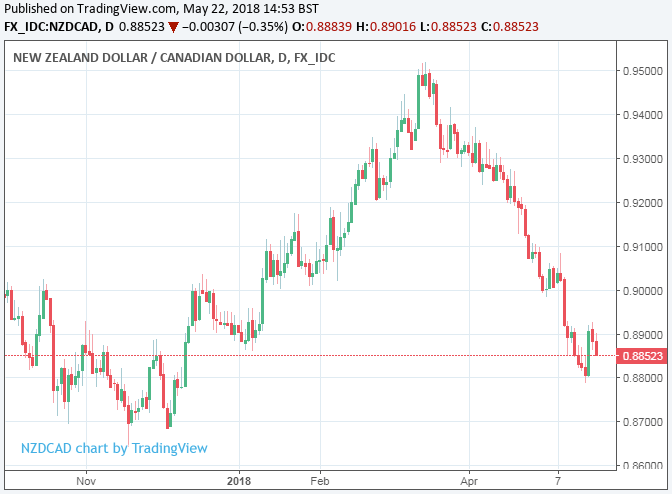Canadian Dollar is a Sell say TD Securities, Eyeing USD/CAD, AUD/CAD and NZD/CAD
- Written by: James Skinner
-
-CAD to underperform as fundamentals deteriorate, NAFTA risks linger.
-Will NOT benefit as US Dollar goes into reverse and resumes downtrend.
-Buy the USD/CAD and AUD/CAD rates, sell NZD/CAD say TD Securities.

© Viv Idrange, Adobe Stock
The Canadian Dollar outlook is growing dimmer by the day, according to strategists at Toronto-based investment bank TD Securities, who argue clients should sell the Loonie against the US Dollar as well as the Aussie and New Zealand Dollars.
Canadian fundamentals are deteriorating in a way that is likely to augur currency weakness during the quarters ahead, market expectations of the Bank of Canada are too high and risks to the economic and currency outlook stemming from the North American Free Trade Agreement negotiations remain high.
"We are growing increasingly bearish on the CAD. Last week's mixed bag of data helped to cool overly optimistic hiking expectations but the cumulative tightening in the curve remains questionable at best. Coupled with a deeply negative basic balance and setback in NAFTA, the currency is running out of positives to hold onto," says Mazen Issa, an FX strategist at TD Securities.
These are all reasons to avoid being exposed to a sudden depreciation of the Canadian Dollar and will mean the Canadian Dollar underperforms its rivals when the US Dollar is forced onto the back foot over the coming days and weeks, as TD forecasts that it will be.
"The USD is beginning to exhibit signs of rally fatigue. The upcoming Fed minutes are likely to contain dovish undertones and could be a tipping point for the USD. With the Fed priced to perfection and appreciable backup in yields, the USD may have exhausted the "divergence" narrative," Issa adds.

Above: Pound Sterling Live graph showing the US Dollar Index during 2018.
Issa and the TD team note that ever since the US Dollar index lifted off from the depths of multi-year lows in late April, the Canadian Dollar has been the most resilient developed world currency when stood before the resurgent greenback.
The US Dollar rebound has been driven by a step higher in American bond yields, which have reached multi-year highs during recent weeks, at a time when currency markets have renewed their focus on interest rate differentials.
The 2-year U.S. bond yield reached 2.57% this week, its highest level since the financial crisis, and the 10-year yield now sits close to a multi-year high of 3.11%. The Canadian 2-year yield has reached 2.03% in May but still sits a long way below its US counterpart, while the 10-year yield has struggled to hold above the 2.5% handle.
The rise in US yields has been steeper than it has for Canadian bonds while any differential at all means investors are incentivised to sell Canadian Dollars and to buy the greenback in order to invest in the American bond market rather than vice versa. Such developments would typically lead the Canadian Dollar lower against its US cousin but the Loonie's weakness has been conspicuously mild in recent weeks.

Above: USD/CAD rate shown at daily intervals.
The flipside to this is that, if TD Securities are correct in forecasting renewed weakness for the greenback over coming days and weeks, the Loonie will have only limited room to exploit it and that should lead to underperformance by the Canadian Dollar.
"The aforementioned backdrop should leave the dollar bloc trading on its front foot. After a tireless beating in the last few weeks, we expect this to be concentrated in AUD and NZD instead of the CAD. As noted yesterday, the CAD has fared the best compared to its G10 peers during the USD rally. And, unlike its antipodean friends, the Bank of Canada is the only central bank that is pricing in 3 hikes by Q1 2019 (compared to a fairly flat structure elsewhere)," Issa explains.
Canadian inflation slipped during the month of April, according to data released last week, suggesting the rise in consumer price pressures seen over recent months was probably as "transitory" as the Bank of Canada said it would be. This data came alongside other figures showing Canadian retail sales undergoing a surprise fall in the month of March, placing a question mark over the likely trajectory of economic growth during the first-quarter.
Issa and the TD team cite this among the reasons why they believe the Bank of Canada is unlikely to live up to market expectations for three interest rate rises during the next ten months. Pricing in interest rate derivatives markets suggests investors currently looking to July and October for the next interest rate rises from the Bank of Canada, which would take the Canadian cash rate to 1.5% and then 1.75%.
The implied probability of a July rate hike is in excess of 80% while the odds of a move in October are around 50%. It would require a substantial improvement in the Canadian economic outlook, or increase in inflation, to shift these odds in favour of further Loonie strength but, conversely it wouldn't take much more bad news to see them move against the currency.
"This, we think, leaves CAD vulnerable to market jitters and data disappointment. This sets up a compelling Relative Value trade within the dollar bloc; though we would expect to see CAD [rise] against both AUD and NZD, we see more juice and attractive risk/reward in NZDCAD topside," says Issa, who has also advocated in a separate note this week that clients bet on a rise in the USD/CAD rate back to the 1.30 level.

Above: NZD/CAD rate shown at daily intervals.
Advertisement
Get up to 5% more foreign exchange by using a specialist provider to get closer to the real market rate and avoid the gaping spreads charged by your bank when providing currency. Learn more here.





